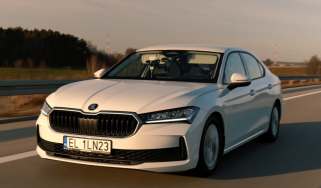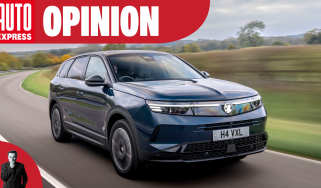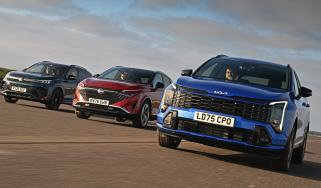Volvo P1800 (Mk1, 1961-1963) icon review: not fast, but just look at it
Volvo’s second take at a sports car was a real hit
It’s said that to make an omelette, you first need to break some eggs. That’s probably the best way to describe Volvo’s attempts at making a sports car in the mid-fifties.
For its first effort, the P1900, the brand – curiously – decided to collaborate with a Californian boat maker, which would make a glass-fibre body for the car. The result is still quite possibly the worst Volvo built in the Swedish company’s near-100-year history. Issues with the model included a bendy frame, ill-fitting doors and fibreglass that had a tendency to crack.
Then-Volvo president Gunnar Engellau is said to have borrowed a P1900 for the weekend and come away disappointed enough to scrap the whole project, with a mere 68 examples having been manufactured.
Its replacement would be a very different beast. The P1800 used a conventional steel shell that was built around a shortened unibody platform taken from the Volvo Amazon. Many of the mechanicals would also be sourced from the Amazon. The P1800 was a pragmatic creation, but it didn’t matter because it looked gorgeous, thanks to delicate Italian styling from a Ghia subsidiary.
Today, it looks tiny. We’ve been loaned a stunning example that’s been part of Volvo UK’s press fleet for the past three decades. This car was built in 1962, which means it was assembled in Britain by Jensen, while the bodies were made in Scotland by Pressed Steel. Initially, Volvo didn’t have the capacity to produce the car itself, but by 1963 that had changed, and further P1800s – at that point renamed the 1800E – were manufactured in Gothenburg, Sweden. Scottish production of the bodies, however, lasted until 1968.
Used - available now

2023 Mazda
CX-5
47,526 milesManualPetrol2.0L
Cash £16,050
2022 Subaru
Forester
40,124 milesAutomaticPetrol2.0L
Cash £19,300
2024 Volkswagen
Tiguan
2,952 milesAutomaticPetrol1.5L
Cash £20,600
2022 Toyota
Corolla Touring Sports
34,264 milesAutomaticPetrol1.8L
Cash £17,000The car feels equally small behind the wheel, although what certainly isn’t tiny is the steering wheel which, compared with modern ones, feels more akin to the helm of a galleon. It sits awkwardly on your lap, with no way of adjusting it to a more comfortable position.
The P1800’s dashboard features a simple but elegant design. Split into two sections, the upper part includes a row of dials, while the lower portion has a neat little drawer plus an array of push/pull knobs for various functions, including the fan and the choke.
Our car’s seatbelt buckle feels positively alien compared with modern equivalents due to its intricate design, and the metalwork is stamped with a patent number. That patent – which concerns the seatbelt’s three-point design – came into effect two years before P1800 production started, and was immediately made available to other manufacturers. This ensured the clever work of Volvo engineer Nils Bohlin would go on to save many hundreds of thousands of lives.
Inertia-reel mechanisms were still a long way off, of course, so it feels a little unnerving to have a belt that never quite fits snuggly. But we won’t be going fast enough to get into trouble today, with the P1800’s 1.8-litre engine serving up a modest 100bhp. Yes, it’s reasonably light compared with a modern sports car, tipping the scales at about 1.1 tonnes, but put your foot down, and it doesn’t feel like all that much is happening.
It certainly sounds like something’s going on though, with the four-cylinder engine making a lovely growl from low down in the rev range up to the 6,000rpm peak-power mark. Changing ratios is done via a fairly slick four-speed manual gearbox with overdrive, sitting on top of a transmission tunnel that eats into the cabin quite dramatically.
There’s a significant dead spot in the middle of the steering, and after that, the response is slow, as is typical of cars from
this era. There’s no power assistance either, so low-speed manoeuvring takes quite a bit of effort. Meanwhile, the brakes need a fair amount of pedal pressure before anything really happens, but they aren’t so bad in terms of stopping strength, featuring discs at the front and drums at the rear.
The P1800 is a comfortable car, with soft suspension that settles quite well after tackling imperfections in the tarmac. The
other side of that is that you get quite a lot of lean in the corners. There’s also not a huge amount of front-end grip on offer either – you don’t have to be getting that carried away before the Volvo starts to understeer.
Dynamic standards are a little bit different all these years on, of course, and in any case, the P1800 was originally pitched more as a GT car than a thoroughbred sports model. On that front, we wouldn’t hesitate to take this thing on a long jaunt, even if the wind noise is a little vocal at cruising speeds.
The P1800 must have seemed expensive when it was new, priced similarly to coupés made with more exotic ingredients. Plus, Volvo wasn’t exactly a brand synonymous with sportiness and desirability. And yet, the car proved reasonably popular, no doubt helped by its role as Roger Moore’s daily driver in the sixties TV series The Saint. Originally, producers wanted an E-Type, which Jaguar declined to supply. Jaguar’s loss, Volvo’s gain.
It also helped that Volvo continually updated the car. Carburettors made way for fuel injection, the 1.8-litre engine was swapped for a 2.0-litre lump, and power steadily increased from the original’s 100bhp to a healthier 130bhp. Giving further appeal, Volvo even added a shooting-brake version, the 1800ES, towards the end of the car’s life.
When production finished in 1973, Volvo had sold nearly 50,000. A fair few more than the disastrous P1900 had managed, then. There wasn’t to be a direct replacement, and while Volvo has dabbled in coupe models over the years, none had the same air of elegance. The Concept Coupe in 2013 was heavily inspired by the P1800, although by the time it made production, it did so sans Volvo branding, becoming the Polestar 1.
Interested in buying one?
Compared with lots of sixties coupé icons, the P1800 is very affordable; £20,000 will buy you a nice, useable example, and you don’t need to spend massively more to get a very tidy one.
The earlier, ‘P’-designated cars built by Jensen are priced at a premium. The 2.0-litre 1800S models appeared in 1968, while the fuel-injected 1800E was on sale from 1969. A year later, Volvo swapped the rear drum brakes for discs. When looking an a P1800, keep an eye out for rust, particularly at the sills. But the whole car needs to be checked thoroughly.
Mechanically you can be assured of the P1800’s robustness, though. Famously, Irv Gordon’s 1966 1800S was sitting on 3.2 million miles by the time he died in 2018.
P1800 Cyan
The P1800 never had the performance to back up its gorgeous looks, but decades on from production stopping, Cyan – formerly known as Polestar Racing – addressed this shortcoming.
The result was a meticulously resto-modded P1800 with a carbon-fibre body, a stiffened structure, independent rear suspension to replace the original live axle, and a 414bhp, 2.0-litre engine from a Volvo S60 World Touring Car.
When Auto Express drove the model in 2020, we noted that at £375,000, the P1800 Cyan was “hideously expensive”, but concluded “for those lucky buyers who nab one, every single drive will feel like an occasion to savour”.
| Model: | Volvo P1800 |
| Production dates: | 1961-1973 |
| Price then: | From £1,500 |
| Price now: | From £20,000 |
| Engine: | 1.8-litre 4cyl petrol, 100bhp |
| 0-62mph: | 11 seconds |
| Top speed: | 110mph |



